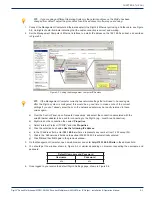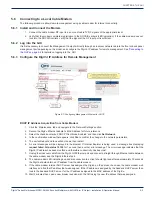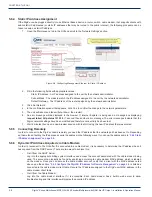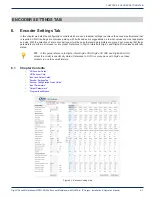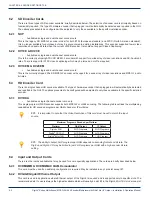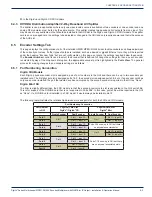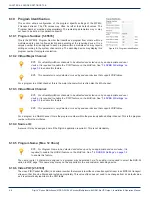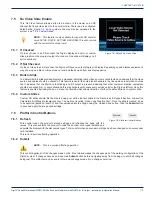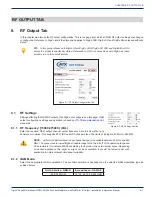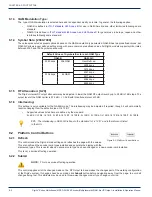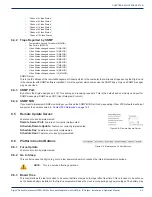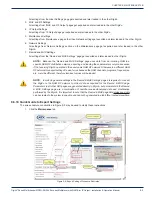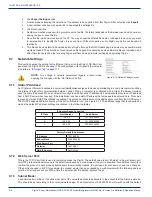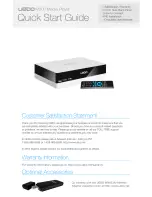
CHAPTER 6: ENCODER SETTINGS TAB
DigiVu
®
Series Multichannel MPEG-2/H.264 Encoder/Multiplexer with QAM &/or IP Output - Installation & Operation Manual
6-7
6.9.7 Saturation: [0-127]
This dialog allows modification of the video signal to increase or decrease color saturation. There are 128 levels available (0-
127) The default value is preset at 66. This setting should not normally require changing. For HD this is not applicable.
6.9.8 Enable Audio:
The audio codec may be disabled if the specific application of the DigiVu does not require an audio program such as a lobby
camera. Disabling the audio codec will result in silence at the receiving TV. Use the drop down box to select the required
setting. The default is Enable.
6.9.9 Audio Codec:
This setting is automatically set to the value appropriate for the detected SD encoder card. A codec converts an audio baseband
signal to a specific streaming audio format. The AC-3 codec supported in DigiVu is 2.0 (two channel stereo). The supported
audio codec depends on the encoder card installed.
6.9.10 Audio Rate:
This drop down displays the audio bit rate options available for each installed encoder. This is the data rate at which an audio
signal is encoded. Each encoder supports commonly used bit rates which range from 192 - 384 kbps. The recommended
audio rate is 192 kbps for stereo audio.
6.9.11 Audio Volume:
This control influences the volume level of the incoming baseband audio signal into the encoder card. This value typically
does not need to be changed from it’s default value but some guidance is provided if audio volume is not satisfactory with
standard settings.
Setting Audio Volume
•
SD Encoder - The scale is 0 - 255 with the default setting of 150.
The value represents a relative volume output and is not an absolute level. If the volume as heard on a TV or other
receiving device is too high or too low, increase the value to increase the output volume or decrease the value to
decrease the output volume. Be careful to not increase the volume excessively as the encoding of extreme high
volumes will cause instability.
•
HD Encoder - The scale is in dB with a default setting of 0 dB.
The value represents a relative volume output and is not an absolute level. If the volume as heard on a TV or other
receiving device is too low, increase the setting to a positive number to increase the output volume. An increase of
10 dB will double the output volume. Be careful to not increase the volume excessively as the encoding of extreme
high volumes will cause instability.
6.9.12 AV Sync:
This adjusts audio/video lip-sync up to +/- 2000 ms if program audio is not in synchronization with the video. With each
adjustment of this value, click
Add to Table
then
Submit all Ports
for the value to become effective, see
for
guidance. If needed, the correct value is found by trial and error.
6.9.13 Offset_X:
This setting allows the adjustment of the horizontal position of VGA input signals only. With each adjustment of this value,
click
Add to Table
then
Submit all Ports
for the value to become effective, see
for guidance. The picture may be
shifted by +/- 50 pixels.
6.9.14 Offset_Y:
This setting allows the adjustment of the vertical position of VGA input signals only. With each adjustment of this value, click
Add to Table
then
Submit all Ports
for the value to become effective, see
for guidance. The picture may be shifted
by +/- 50 pixels.
6.9.15 VBI Value:
This tick box enables Closed Caption (CC) support in the Vertical Blanking Interval (VBI). Only the value appropriate to the
installed encoder will be available in the drop down. The video encoders do not create a closed caption, they capture existing
closed captions on incoming video and convert them to a digital format.
•
ATSC_CC
Enables the processing CC data for ATSC (In cards VWEB_NA, VWEB_NA_1, DV1HDA).
•
ETSI_CC
Enables the processing of CC data for the ETSI (not currently implemented).
•
NONE
Disables the closed caption function.



